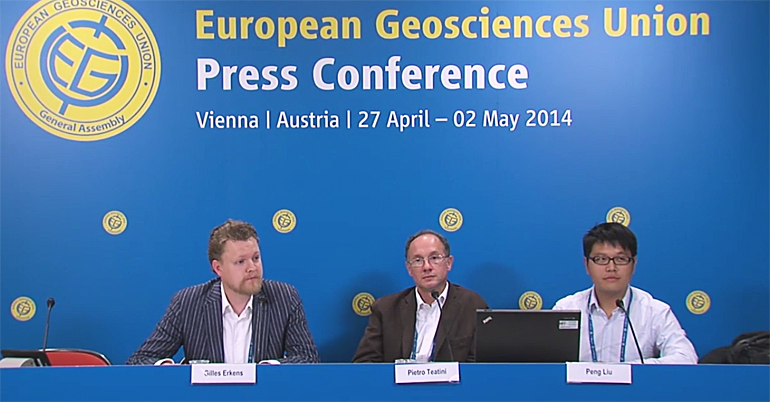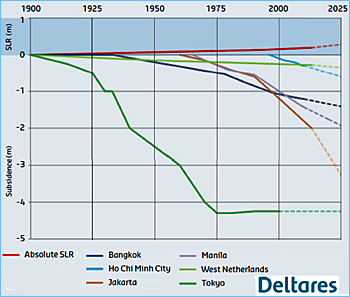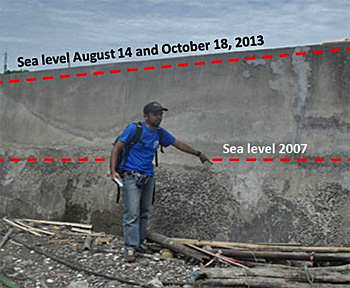EGU2014: Land subsidence in coastal megacities outranges sea level rise

In many coastal cities, the ground is now sinking faster than the sea level is rising due to climate change. Parts of Jakarta, Ho Chi Minh City, Bangkok and many other coastal cities have already sunk or are threatened to sink below sea level. This subsidence is the result of human activity, namely the pumping of groundwater.
Geologist Gilles Erkens (left on top photo) of the Dutch research institute Deltares announced the results of an subsidence assessment on five coastal megacities, Jakarta, Ho Chi Minh City, New Orleans, Dhaka and Bangkok in a press conference at the 2014 General Assembly conference of the European Geosciences Union (EGU) in Vienna, Austria on 28 April.
 A quick assessment of sea level rise (upper red line) and subsidence in coastal cities. Note the subsidence in Tokyo (bottom green line) stopped in the 70s following groundwater extraction measures.
A quick assessment of sea level rise (upper red line) and subsidence in coastal cities. Note the subsidence in Tokyo (bottom green line) stopped in the 70s following groundwater extraction measures.
Under-appreciated problem
The study reveals that the total damage due to subsidence worldwide is estimated at billions of dollars a year. In the future, this will only increase, through the growth in both population and economic activities. Subsidence is an underrated problem worldwide.
How much and how quickly it can proceed is apparent in North Jakarta, where the city has sunk four metres in the last 35 years, a fall of 10-20 cm per year. The consequences of floods increase due to subsidence – the area remains deeper under water for longer.
The economic damage rises and the risk of more victims is increased. Also, movements in the ground cause significant economic losses in the form of structural damage and high maintenance costs for roads, railways, dikes, water pipes, pumping stations and buildings.
Groundwater extraction as primary cause
Groundwater extraction due to urbanisation and population growth is the primary cause of serious subsidence in the megacities, but this is where the solution also lies. Besides this, coastal cities are confronted with greater natural subsidence, and they are usually built on weak soils.
However, subsidence only occurs in the place where the groundwater is being extracted. This is in contrast to climate-driven sea level rises which are a problem for all coastal cities. The solution to subsidence must be found in the city itself.
 High sea levels in 2013 almost overtopped the flood wall of Jakarta. This picture suggests the sea level is rising but in fact the wall is lowering.
High sea levels in 2013 almost overtopped the flood wall of Jakarta. This picture suggests the sea level is rising but in fact the wall is lowering.
Governments unaware of problem
Government bodies and inhabitants are often not aware that subsidence is an urgent problem. A different way of thinking and an integral approach are needed to stop subsidence.
The present reaction to a flood is more often to build a barrier. But if the flood was partly caused by subsidence, in the course of time, the barriers will no longer suffice, because the actual cause of the problem – the extraction of groundwater – is not addressed.
Subsidence must be included along with water safety in the planning processes for the medium and long term. In their future scenarios, many governments only target the consequences of sea level rises, but subsidence is an equally urgent issue.
The sea is rising by three to ten millimetres a year; the ground may sink up to 100 mm a year.
Download Erkens' presentation at EGU: Sinking Coastal Cities (as pdf)
The news item was originally published on the website of Deltares.
More information
Deltares
Delft, the Netherlands
+31 88 335 8273
www.deltares.nl



